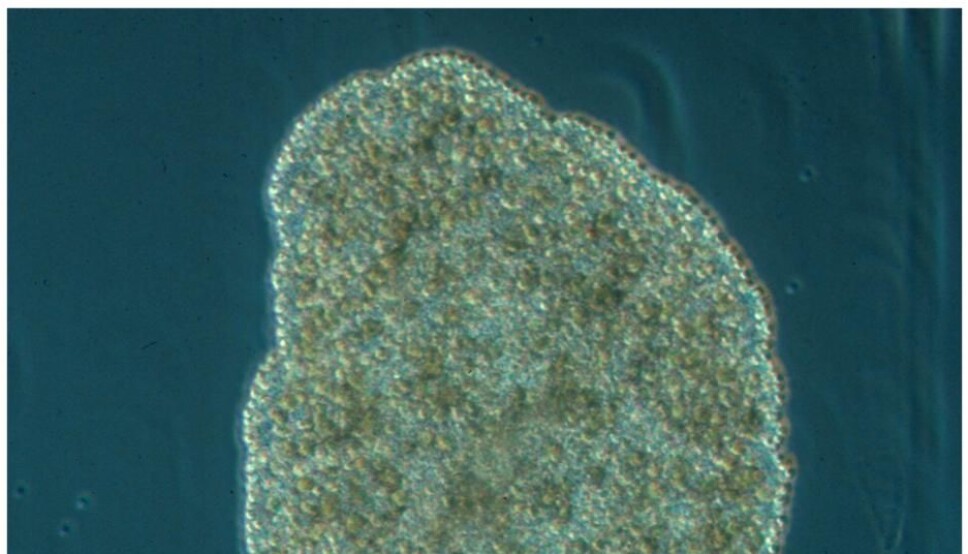Researchers' Zone:

What is the point in having a nervous system?
Can some animals really exist without a nervous system? Trichoplax, an animal that evolved about a billion years ago, might give us an answer.
The nervous system is what allows us to sense our surroundings and act in the outside world. All our thoughts, senses, actions and movements are based on it.
The same goes for all other animals we are in contact with: dogs, horses, starfish, ants, earthworms and even animals as simple as corals and jellyfish.
It is hard to imagine how an animal would be able to cope without a nervous system.
And yet the nervous system must have evolved gradually in some of the first animals. This is where Trichoplax enters the picture.
A sticky hairy plate
Trichoplax belongs to the placozoan branch of the animal kingdom, and it is one of the most primitive animals there is. It consists of multiple cells, and it is therefore - despite being similar in appearance - not related to amoeba.
The structure of Trichoplax can best be described as a one millimetre thick sandwich that consists of two layers of surface cells with a single layer of inner cells. In total, there are six cell types: upper epithelial cells, lower epithelial cells, fibre cells, lipophilic cells, gland cells and crystal cells.
Despite the simple structure, Trichoplax has been a great success evolutionarily speaking, and it is unlikely to have changed much in the last billion years.

However, Trichoplax were first discovered in 1883 by the German marine biologist F. E. Schulze. He discovered a Trichoplax crawling around the inside of a saltwater aquarium.
Over the following years, Schulze described the animal in more detail and provided the scientific name Trichoplax adhaerens, which means sticky hairy plate.
Lethargic pace and a mysterious sex life
In the wild, Trichoplax live on the seabed close to the coast in temperate and tropical regions.
Trichoplax are not busy animals – they rarely move more than a few centimetres per hour. They also have no reason to do so, as they feed on algae and apparently do not have many natural enemies.
Finding a partner is also not an urgent matter, as they mainly multiply by splitting themselves in two. However, while the Trichoplax' complete lifecycle has not been fully explained, there is much evidence that Trichoplax also have sex. Small embryos are described in laboratory cultures of Trichoplax, but never larger than 128 cells, after which they perish.
For these reasons, Trichoplax are also easy to have in a laboratory, and more and more scientists around the world are starting to do that.
Trichoplax have a very interesting position in the evolutionary history of animals.
No nerve cells – how is this possible?
Almost 10 years ago, Trichoplax' genome was sequenced to investigate which genes it possesses.
This showed that Trichoplax possess one of the smallest genomes ever studied. Most surprisingly, however, it also turned out that Trichoplax possess virtually all the machinery needed to have a functioning nervous system.
But there is one problem: on closer inspection of Trichoplax under a microscope, there is no evidence that there are nerve cells.
But despite the lack of a nervous system Trichoplax is able to perform relatively quite complex behaviours.
Trichoplax, for example, can move, sense the presence of food, stop and devour algae, and sense gravity.
This may sound very simple, but considering what Trichoplax has to work with, it does it pretty well. Keep in mind how essential the nervous system is to all other animals; without it we would have no senses, thoughts or actions.
But how can the individual cells in Trichoplax agree on what to do?
Movement without muscles
An essential task for any animal is to find nutrition. This also applies to Trichoplax, which has done the job in a remarkable way.
First and foremost, Trichoplax must find algae to eat, which it does by moving around in more or less random patterns on the seabed.
However, Trichoplax does not move using muscle contraction, as it has no muscles at all. Trichoplax uses so-called cilia.
Cilia sit on the outside of the epithelial cells, giving Trichoplax a 'hairy' exterior. Some of our own cells also have cilia – for example, the cells in our lungs, which help remove unwanted particles by moving them along.
In a very similar way, the cilia of the Trichoplax beat and thus create movement – though not of surrounding particles, but of the Trichoplax itself.
When the Trichoplax eventually encounters some algae, it is essential that it can stop moving. How exactly Trichoplax can sense the presence of appropriate food is unknown, but it is clear that they can.
Trichoplax' cells 'communicate' without a nervous system
But how is a single algae-sensing cell able to signal all other cells to stop moving, without a nervous system?
The passing on of information is basically what the nervous system has evolved to do, but Trichoplax shows that there are other ways of doing it.
It turns out that Trichoplax possesses a number of signalling molecules that are very similar to certain neurotransmitters in our nervous system. When one of the so-called gland cells senses the presence of algae, it releases a certain molecule, called TadELP, into the tiny volume beneath the animal.
TadELP causes the cilia to stop beating, thereby causing the animal to pause.
There is just one problem: the content of TadELP in a single gland cell is not enough to affect all cilia. The solution to this is that TadELP also contains a different effect. It causes other gland cells to release their content of TadELP, resulting in all the cilia coming to a halt.
TadELP thus acts a bit like signalling molecules in our nervous system, but they are not released as quickly and as accurately as in our nervous system.
And yet Trichoplax uses TadELP to pass on information, and this is an essential step towards a functioning nervous system. Gland cells may therefore constitute an early stage in nervous system development.
Digestion without a gut
Now Trichoplax is in a position to be able to consume its meal of algae, but unlike virtually any other animal, Trichoplax has neither a mouth nor a gastrointestinal system.
Instead of having 'inner digestion', which we have, Trichoplax uses 'external digestion'.
The so-called lipophilic cells are Trichoplax' digestive cells, and they contain large pockets of digestive enzymes that are very similar to ours. When Trichoplax pause over the algae, these enzymes are released onto the algae, which is thereby broken down.
After this, it is a small matter of the cells absorbing the nutrients from the digested algae.
Mysterious fibre cells may be key to understanding Trichoplax
Although we have a good idea of how Trichoplax finds its nutrition, there are still many unanswered questions about Trichoplax' behaviour.
We know, for example, that crystal cells can sense gravity, but how that signal is passed on to the rest of the animal remains a mystery.
One possibility is the fibre cells.
The function of fibre cells remains unknown, but based on their appearance under the microscope, it is possible that they may somehow transmit signals.
The fibre cells have long branches that are in close contact with other cells, giving them a slightly similar appearance to nerve cells. However, there is much to suggest that they do not function as neurons. Among other things, there are no synapses between the fibre cells and other cells.
How the nervous system evolved is an interesting biological question that might give us a better understanding of how our own nerve cells are constructed. Both Trichoplax' gland and fibre cells have similarities to our nerve cells and may give us part of the answer.
Time will tell whether the fibre cells form an alternative communication network in Trichoplax to the nervous system in us. Whatever the case, Trichoplax will continue its tenacious and utterly carefree wandering for algae – there are some benefits, after all, of not having a nervous system.
Translated by Stuart Pethick, e-sp.dk translation services. Read the Danish version at Videnskab.dk's Forskerzonen.
References:
Thomas Lund Koch's profile (KU)
'The Trichoplax genome and the nature of placozoans'. Nature (2008). DOI: 10.1038/nature07191
'Global Diversity of the Placozoa'. PLoS ONE (2013). DOI: 10.1371/journal.pone.0057131
'My favorite animal, Trichoplax adhaerens'. BioEssays (2005). DOI: 10.1002/bies.20320




